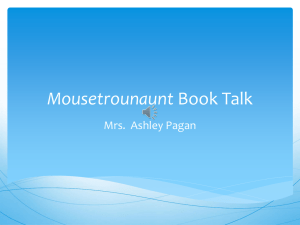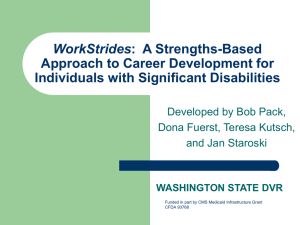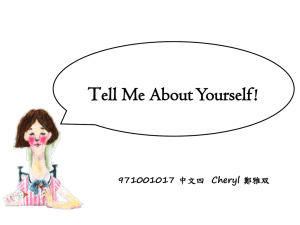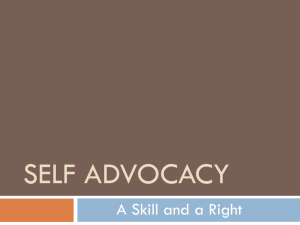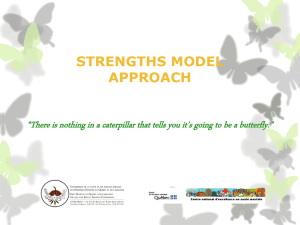NEW Developmental strengthsquest-presentation
advertisement
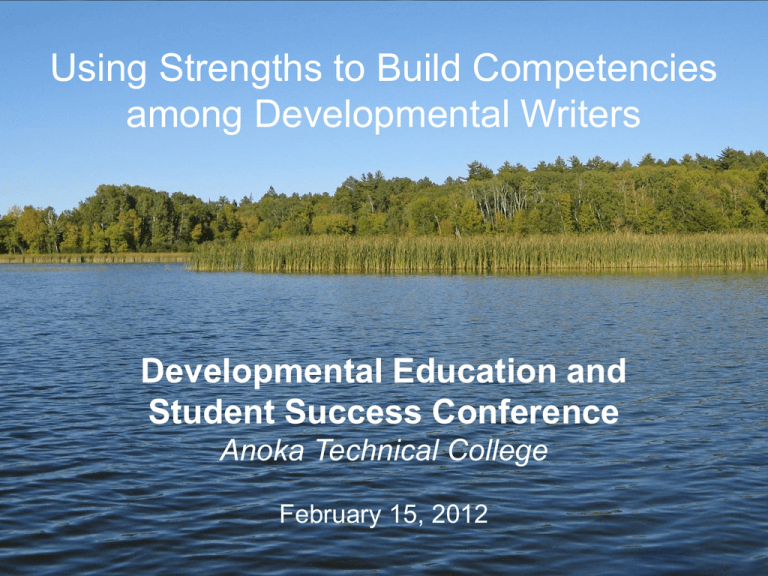
Using Strengths to Build Competencies among Developmental Writers Developmental Education and Student Success Conference Anoka Technical College February 15, 2012 Using Strengths to Build Competencies among Developmental Writers Presented by Anoka Technical College Elena Favela Counselor Steve Jaksa English Faculty Diana Ostrander English Faculty This presentation will be available from our Blog site: www.atcstrengths.wordpress.com Elena Favela ATC Counselor Creating a Culture of Learning Program Overview This session will provide examples of how Anoka Technical College has leveraged the power of the StrengthsQuest assessment for student development, with a focus on the needs of developmental students. Program Overview • Who we are – ATC demographics • Goals of Strengths Integration • Student Support Services -Brand New Student Success Center - Student Success Coaches • Institutional Strategies • Developmental English -Curriculum -Impact on successful completion •Summary, Q & A Minnesota State Colleges & Universities Mission - Provide innovative career and Mission and Vision technical education to help our students and communities live and learn well. Vision - A vital student- and communityfocused institution, providing the finest career and technical education in Minnesota. Anoka Technical College offers over 85 degree Anoka Technical College offers over diplomas, 85 degree awards awards (certificates, AAS – 2 year (certificates, diplomas, degrees) in 36 program areas. Assoc. of Applied Science – 2 year degrees) in 36 program areas ATC Demographics 3,643 students, 1,856 Full Time Equivalent students (percentages are of all students enrolled) 61% are women 55% are over age 25 42% are undergraduate transfer students 17% are students of color 27% are first generation status students 54% are Pell-eligible (low income) 67% are enrolled part-time (11 credits or less per semester). The average class size is 20 students and 20 students per lab. What is StrengthsQuest? Goals of SQ Integration #1 Provide learning opportunities for all employees to maximize talent. -Dr. Shari Olson Staff and faculty professional development - ongoing Goals of SQ Integration #2 Create new models for Student Success in Academic and Student Support Programming. – Dr. Shari Olson Goals of SQ Integration #3 Create a culture of continuous improvement. -Dr. Shari Olson ATC Remains a Strengths-Based College under Our New Administration, 2011-12 Dean of Student Affairs Gary Schindler President Jessica Stumpf Vice-President Catherine Gatewood Interim Academic Dean Sherry Wickstrom STRATEGIES USED 2010-2012 Institutional Strategies INSTITUTIONAL STRATEGIES: Grassroots Approach Integration into over half of our academic and technical programs, developmental, and general education courses INSTITUTIONAL STRATEGIES: Grassroots Approach Creation of a new transferrable General Education course – COMM 1050 Strengths and Wellbeing Spring 2011 80% graduated or are still enrolled Spring 2012 INSTITUTIONAL STRATEGIES: Grassroots Approach Addition of Three SUCCESS COACHES •Holistic, student-focused, strengths-based coaching •Meet students where they are during all stages of their academic career •Use strengths to help students: -Positively reframe their situation -Proactively problem solve -With academic skills development and goal reaching New Student Orientation • All new students take the SQ assessment during their orientation session • Begin the shared language between student and institution Institutional Impact Spring to Spring Persistence (still enrolled) 60.00% 47.80% 49.16% 51.13% 2011 2012 47.64% 44.02% 50.00% 41.03% 40.00% 30.00% 20.00% 10.00% 0.00% 2007 2008 2009 2010 WHY STRENGTHS? Voices of the people ATC: Building Student Success Through Strengths and Well Being Dr. Diana Ostrander ATC English Faculty Strengths-Based Developmental Curriculum: 1. Replaces “Remediating” with “Maximizing.” 2. Translates Students’ Strengths-Confidence into Academic Confidence. 3. Is Community-Based and Provides a Shared Strengths Language and Culture. 4. Is Relevant to Students’ Lives, Interests and Needs. 5. Permits Instructors to Know Students’ Unique Talents, Overriding Stereotypes. 6. Provides Instructors with Guidance about How to Motivate and “Manage” Students for Their Success. 7. Brings Results of Increased Engagement and Success. 1. “Remediation”: A Barrier, or Means to Graduation? Ohio Dept. of Education “Race to the Top” Alignment Project Data 2012 The Strengths Path to Retention • The non-academic factors of academic self-confidence and achievement motivation have a positive relationship to retention and “the strongest relationship to college GPA” (ACT Policy Report 1). • “The caring attitude of college personnel is the most potent retention force on a campus,” by helping students learn to use their talents and strengths. (Noel, Levitz, & Saluri 17). Remediating vs. Maximizing “To produce excellence, you must study excellence” (SQ xv). “What would we do if we really loved our students?” (SQ v). “More students leave college because of disillusionment, discouragement, or reduced motivation than because of lack of ability or dismissal by school administration” (SQ ix). “The deficit-based, remediation programming I had used for more than 10 years interfered with students becoming top achievers,” programming that is still the “most prevalent approach used today” (xiv). --Edward “Chip” Anderson, UCLA, 1998 ZPD (Lev Vygotsky) vs. Strengths as Scaffolding The Zone of Proximal Development, or “ZPD,” is "the distance between the actual developmental level as determined by independent problem-solving and the level of potential development as determined through problem-solving under adult guidance or in collaboration with more capable peers." (Vygotsky 86) Zones of Strengths Development Success Attendance - Retention - GPA Credits Earned – Graduation Employment Student Changes Hope - Expectations - Motivation Engagement - Self-Efficacy Wellbeing Strengths Development Knowledge & Skills X Talents = Strengths 2. Strengths Confidence: What was your first thought when you learned your top-five strengths? Wow, I guess I am really like that! How neat. Surprised on a couple & confident on the others. Definitely describes me. It hit my strengths right on the button. They fit me and who I am as a person. They fit and reinforced my ideals of myself. I feel they fit me well. That's so me!!! I strongly agreed with most of them. Good feedback. Totally awesome. Spot on! I thought they fit me well. Seems to describe me perfectly. (Student Survey, 2/7/12) 1. How Strengths Confidence Leads to Enhanced Academic Confidence and Performance “You like to explain, to describe, to host, to speak in public, and to write. This is your Communication theme at work. Ideas are a dry beginning. Events are static. You feel a need to bring them to life, to energize them, to make them exciting and vivid. And so you turn events into stories and practice telling them. You take the dry idea and enliven it with images and examples and metaphors. .. This is why people like to listen to you. Your word pictures pique their interest, sharpen their world, and inspire them to act.” Which of your strengths makes you feel excited to be attending college?” (ATC Student Survey, 2/7/12) “Stretching myself intellectually and emotionally. My connectedness strength is a big part of that. I feel like I am surrounded by equals when I am on campus. I like that everyone is treated the same at ATC.” “That I am a learner and an input person.” ”The WOO. Many positions are more about the human condition than actual skill sets than can be taught. My personality and how I interact can go a long way if I have the basic technical skills to do the job.” “That I am being responsible with my future and pursuing my goals in life. I would have to say that my responsibility strength makes me feel this way!” “Positivity, I believe all things happen for a reason; remain positive, and things will change.” “Having a plan to achieve the life I want to live; the strengths that make me feel this way are futuristic and strategic.” Achiever, because it's great to be recognized for achieving.” 3. Adding Greater Relevance: Developmental English Essay Assignments with SQ 1. “Passion” Essay Introduction to Writing and Strengths (Community/Relationship-Building) 2. Job Search Unit: Cover letter, Resume, Follow-up Letter (Functional Resume stresses strengths) (Career) 3. “Tell Me about Your Strengths?” Essay Interview preparation with defined strengths and examples (Career) 4. Advisor Interview Essay: Initiates a Program- and Strengths-Based Mentoring Relationship, before students enter the program. (Academics) 5. Scholarship Application Essay: Responds to Application Questions/Due prior to deadline (Academics, Money) 6. Legacy Letter: Reflective Writing addressed to future course participants (Community/Relationship-Building) Strengths + Developmental Writing Goals Strengths help us reach our developmental education goals: •To preserve and make possible educational opportunity for each postsecondary learner. •To develop in each learner the skills and attitudes necessary for the attainment of academic career and life goals. •To ensure proper placement by assessing each learner's level of preparedness for college course work. •To maintain academic standards by enabling learners to acquire competencies needed for success in mainstream college courses. •To enhance the retention of students. •To promote the continued development and application of cognitive and affective learning theory. (http://www.nade.net/AboutDevEd.html) Student Responses - Developmental English Survey - May 2011 “A change I’ve noticed is an ‘I can do’ attitude.” “My friends and family have seen me change since I have found and been using my strengths.” “It helps me as a student, or on my job by showing me my abilities and the reason why some things come easily and not others.” “Knowing my strengths affects me a lot, every single day, what I believe I can do. You know that you'll always have those qualities, and you can drawn on them to get you through whatever you face in life.” “This is one of the best tools I’ve come across since starting college.” “The facts about these strengths have put me in a better place.” “What I’ve learned is that everyone is different--some people are better at being sensitive and others are amazing learners and thinkers. It helps people to get along, and we can help each other in strengths that we don't have, to share.” “ Knowing my strengths has helped me identify qualities in my children.” “I have been able to dig into my strengths and use them more efficiently.” 5. Knowing Students’ Strengths Overrides our Stereotypes 4. Strengths Provide a Shared Language and Culture of Learning James, Mechanical Drafting Ideation, Learner, Empathy, Achiever, Restorative Jesse, Automotive Ideation, Learner, Strategic, Significance, Deliberative The Four Domains of Leadership Strength Executing Influencing Relationship Building Strategic Thinking Achiever Arranger Belief Consistency Deliberative Discipline Focus Restorative Activator Command Communication Competition Maximizer Self-Assurance Significance Woo Adaptability Developer Connectedness Empathy Harmony Includer Individualization Positivity Relator Responsibility Analytical Context Futuristic Ideation Input Intellection Learner Strategic ocial + Academic tegration and Student uccess with Strengths StrengthsQuest StrengthsQuestDistribution Distributionby byCluster Cluster for forDevelopmental Basic English Students Students Based Basedonontop Top 5 Strengths 5 Strengths Strategic Thinking, Strategic 21% Thinking 21% Executing Executing 27%28% InfluencingInfluencing 10% 8% Relationship 42% Relationship 42% University of Wyoming’s Findings Regarding Strengths UW Students’ Strengths Summary: • Honors students’ top strengths include achiever, input, learner, responsibility, and adaptability. • Underprepared students’ (conditionally-admitted) top strengths include adaptability, woo, positivity, includer, and empathy. • All other incoming students’ top strengths include adaptability, includer, restorative, achiever, and positivity. “Teaching with StrengthsQuest” (http://www.uwyo.edu/learn/_files/docs/brownbag_docs/strengthsquest.pdf) Of the “underprepared” group’s strengths, all but “WOO” are in the Relationship Domain. Percent of Strengths for All Students by Theme, Clustered in the Four Groups The 34 languages of strengths give instructors effective, customized motivational language for each student that can increase persistence and retention. 7. RESULTS: Retention Before (Fall) and After (Spring) StrengthsQuest Infusion in Basic English Courses 90 80 87 83 79 70 Percent of Students 60 71 Percent "C" or better 50 Percent Completion 40 30 ATC Fall to Spring Retention: Developmental English 20 10 0 Fall - Before SQ Spring - after SQ ATC Developmental New-Student Retention: Year-to-Year Increase of 10.31% (2010-2012) 45.00% 42.50% 40.00% 35.00% 30.00% 32.19% 25.00% 20.00% 15.00% 10.00% 5.00% 0.00% Fall 2010 to Fall 2011 Spring 2011 to Spring 2012 Semester-to-Semester Developmental New-Student Retention 11% Increase: Fall to Spring, 2011 to 2012 70.00% 64.40% 60.00% 50.00% 53.41% 40.00% 30.00% 20.00% 10.00% 0.00% Fall 2010-Spring 2011 Fall 2011-Spring 2012 And One More Thing… The Four Domains of Leadership, Collegewide Goals, and Assessment Strengths Domains • Influencing • Strategic Thinking • Relationship Building • Executing Collegewide Goals • Communication • Critical Thinking • Interaction • Ethical DecisionMaking Strengths-Based Assessment 1. Student Engagement in Strengths within Curriculum 3. Enthusiasm about Strengths Achieves College-wide Goals 2. Strengths and Collegewide Goals Meet in Curriculum ATC Strengths Blog: www.atcstrengths.wordpress.com “I always had this low self-esteem, a fear of not succeeding in life. Now, since there are resources and the help I need to be successful, I feel very comfortable attending college. I can now be successful, knowing I have a gift locked inside me.” (Student Strengths Survey, 2/7/12) Steve Jaksa, ATC English Instructor Using SQ in Connection with Writing Assignments • Job-Search Tool SQ provides a ready means for students to begin exhibiting and articulating the talents that make them suitable candidates. • Organizing Framework for Writing The format of 34 defined strengths allows students to organize and present their thoughts conceptually. • Reading-Writing Connection The strengths themes run through the assigned readings and writings, providing continuity. Using SQ in Connection with Class Readings (Grassroots Text) • Support for Reluctant Readers Strengths allow a personal connection between character and reader. This can enliven a text for someone who tends not to read or who struggles with reading. • Real-Life Illustrations This personal connection allows students to see in the stories their own and others’ strengths in practice. • SQ Literary Theory Strengths also provides a tool for literary analysis, and an additional interpretive level on which we can discuss readings. SQ in a Reading Exercise: Diane Sawyer’s “Daring to Dream Big” What strengths motivate Sawyer to both dream big and to achieve those dreams? (Excerpt) http://uponthesacredstage.blogspot.com/ 2008/06/diane-sawyer.html Sample Classroom Exercise: Excerpt from Diane Sawyer’s “Daring to Dream Big” “She was one of the judges. A well- known writer. A woman whose seagray eyes fixed on you with laser penetration, whose words were always deliberate. She felt the right words could make all the difference. Her name was Catherine Marshall. From the first moment I met her, I was aware that she was holding us to a more exacting standard. While other pageant judges asked questions about favorite hobbies and social pitfalls, she sought to challenge. “During the rehearsal on the last day of the pageant, several of us were waiting backstage when a pageant official said Catherine Marshall wanted to speak with us. Most of us were expecting a last-minute pep talk, but we were surprised. She fixed her eyes upon us. "You have set goals for yourselves, but I don't think you have set them high enough. You have talent and intelligence and a chance. I think you should take those goals and expand them. Think of the most you could do with your lives. Make what you do matter. Above all, dream big." “Dare to Dream Big” Strengths Maximizer: People who are especially talented in the Maximizer theme focus on strengths as a way to stimulate personal and group excellence. They seek to transform something strong into something superb. Developer: People who are especially talented in the Developer theme recognize and cultivate the potential in others. They spot the signs of each small improvement and derive satisfaction from these improvements. Command: People who are especially talented in the Command theme have presence. They can take control of a situation and make decisions. Futuristic: People who are especially talented in the Futuristic theme are inspired by the future and what could be. They inspire others with their visions of the future (StrengthsQuest Activity Workbook). Questions? Learn More About Our Strengths Journey at: • www.atcstrengths.wordpress.com Thank you for attending our session! This presentation will be available from our Blog site: www.atcstrengths.wordpress.com Works Cited Vygotsky, L. S. (1978). Mind in Society: The Development of Higher Psychological Processes. M. Cole, V. John-Steiner, S. Scribner, E. Souberman (Eds.). Cambridge, MA: Harvard University Press.
